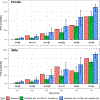Development and Validation of a Hypertension Risk Calculator for Living Kidney Donors
- PMID: 36727726
- PMCID: PMC10205650
- DOI: 10.1097/TP.0000000000004505
Development and Validation of a Hypertension Risk Calculator for Living Kidney Donors
Abstract
Background: Ideally, when deciding whether to donate, kidney donor candidates would understand their long-term risks. Using single-center data (N = 4055; median [quartiles] follow-up: 18 [9-28] y), we developed a calculator for postdonation hypertension and validated it using long-term data from an external single-center cohort (N = 1189, median [quartiles] follow-up: 9 [5-17] y).
Methods: Risk factors considered were routinely obtained at evaluation from donor candidates. Two modeling approaches were evaluated: Cox proportional hazards and random survival forest models. Cross-validation prediction error and Harrell's concordance-index were used to compare accuracy for model development. Top-performing models were assessed in the validation cohort using the concordance-index and net reclassification improvement.
Results: In the development cohort, 34% reported hypertension at a median (quartiles) of 16 (8-24) y postdonation; and in the validation cohort, 29% reported hypertension after 17 (10-22) y postdonation. The most accurate model was a Cox proportional hazards model with age, sex, race, estimated glomerular filtration rate, systolic and diastolic blood pressure, body mass index, glucose, smoking history, family history of hypertension, relationship with recipient, and hyperlipidemia (concordance-index, 0.72 in the development cohort and 0.82 in the validation cohort).
Conclusions: A postdonation hypertension calculator was developed and validated; it provides kidney donor candidates, their family, and care team a long-term projection of hypertension risk that can be incorporated into the informed consent process.
Copyright © 2023 Wolters Kluwer Health, Inc. All rights reserved.
Conflict of interest statement
The authors declare no conflicts of interest.
Figures

References
Publication types
MeSH terms
Grants and funding
LinkOut - more resources
Full Text Sources
Medical

